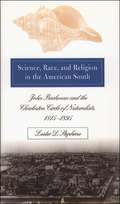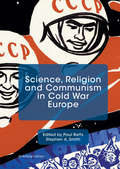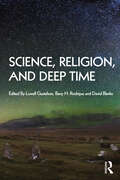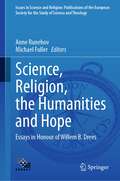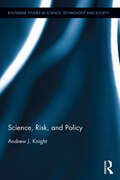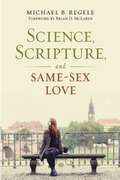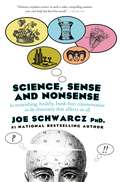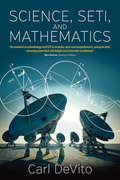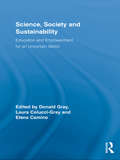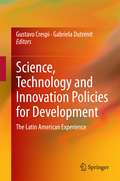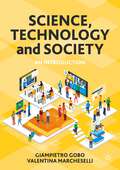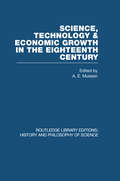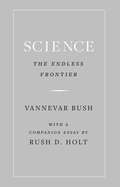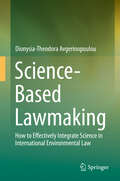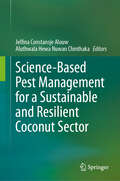- Table View
- List View
Science, Psychoanalysis, and the Brain
by Shimon MaromScience, Psychoanalysis, and the Brain is an invitation to a space for dialogue where reflections on neurophysiology are expressed with and guided by depth-psychology in mind; a space where neurophysiology resumes its traditional humbled stance towards matters of the psyche, and where the intellectual autonomy of depth psychology is acknowledged. The author leads the reader through the terrain of methodological errors that have plagued recent reductive approaches, paving the way for a dialogue that is based on an alternative, relational approach. Neurophysiology is discussed on a high level of abstraction, enabling a genuine analysis of the organization of the brain through its relational interactions with the world. In this dialogue, where psychology provides a theoretical framework that contributes to physiology, both parties benefit. Neurophysiology gains important constraints and guidance in phrasing meaningful questions, whilst psychology gains further motivation to crystalize its multifaceted concepts. Both disciplines enrich the spectrum of metaphors available to them within their own discourses.
Science, Race, and Religion in the American South
by Lester D. StephensIn the decades before the Civil War, Charleston, South Carolina, enjoyed recognition as the center of scientific activity in the South. By 1850, only three other cities in the United States--Philadelphia, Boston, and New York--exceeded Charleston in natural history studies, and the city boasted an excellent museum of natural history. Examining the scientific activities and contributions of John Bachman, Edmund Ravenel, John Edwards Holbrook, Lewis R. Gibbes, Francis S. Holmes, and John McCrady, Lester Stephens uncovers the important achievements of Charleston's circle of naturalists in a region that has conventionally been dismissed as largely devoid of scientific interests. Stephens devotes particular attention to the special problems faced by the Charleston naturalists and to the ways in which their religious and racial beliefs interacted with and shaped their scientific pursuits. In the end, he shows, cultural commitments proved stronger than scientific principles. When the South seceded from the Union in 1861, the members of the Charleston circle placed regional patriotism above science and union and supported the Confederate cause. The ensuing war had a devastating impact on the Charleston naturalists--and on science in the South. The Charleston circle never fully recovered from the blow, and a century would elapse before the South took an equal role in the pursuit of mainstream scientific research.
Science, Religion and Communism in Cold War Europe
by Stephen A. Smith Paul BettsReligion and science were fundamental aspects of Eastern European communist political culture from the very beginning, and remained in uneasy tension across the region over the decades. While both topics have long attracted a great deal of scholarly attention, they almost invariably have been studied discretely as separate stories. Religion, Science and Communism in Cold War Europe is the first scholarly effort to explore the delicate interface of religion, science and communism in Cold War Europe. It brings together an international team of researchers who address this relationship from a number of national viewpoints and thematic perspectives, ranging from mysticism to social science, space exploration to the socialist lifecycle, and architectural heritage to pop culture.
Science, Religion and Deep Time
by Lowell Gustafson Barry H. Rodrigue David BlanksThis book examines the meaning of religion within the scientific, evidence-based history of our known past since the big bang. While our current major religions are only centuries or millennia old, our volume discusses the origins and development of human religious practice and belief over our species’ existence of 300,000 years. The volume also connects the scientific approach to natural and social history with ancient truths of our religious ancestors using new lines of inquiry, new technologies, new modes of expression, and new concepts. It brings together insights of natural scientists, social scientists, philosophers, writers, and theologians to discuss narratives of the universe. The essays discuss that to apprehend religion scientifically, or to interpret and explain science theologically, the subject must be examined through a variety of disciplinary lenses simultaneously and raise several theoretical, philosophical, and moral problems. With a singular investigation into the meaning of religion in the context of the 13.8 billion-year history of our universe, this book will be indispensable for scholars and students of religious studies, big history, sociology and social anthropology, philosophy, and science and technology studies.
Science, Religion, the Humanities and Hope: Essays in Honour of Willem B. Drees (Issues in Science and Religion: Publications of the European Society for the Study of Science and Theology #8)
by Michael Fuller Anne RunehovThis book collects a multidisciplinary range of contributions focusing on the prolific and seminal work of Willem Drees in the fields of philosophy of religion, philosophy of the humanities, and science and theology/religion. Trained in both theoretical physics and theology/philosophy of religion, Drees holds doctoral degrees in both theology and in philosophy and, amongst other distinguished positions, held professorships at the University of Leiden and at the University of Tilburg. Drees was also Editor-in-Chief of Zygon, Journal of Religion & Science, between 2008 and 2018, and served as President of the European Society for the Study of Science and Theology (ESSSAT) between 2002 and 2008. In 2018, he was elected as member of the Royal Holland Society of Sciences and Humanities (KHMW). This contributed volume builds on Drees’ expansive and provocative scholarly contributions, notably around the concept and meaning of naturalism and the humanities to the fields of science and religion, as exemplified by his works Religion, Science and Naturalism (1996) and What Are the Humanities For? (2021). In a time where more and more young people across the globe are entering higher education such cross-disciplinary explorations and (re-)evaluations are vital to the field. Accordingly, by approaching his work from a variety of disciplines this collection illuminates the broad reach of Drees’ work and provides scholars from various fields with many new and rich opportunities avenues for research.
Science, Risk, and Policy (Routledge Studies in Science, Technology and Society #32)
by Andrew J. KnightFor decades, experts and the public have been at odds over the nature and magnitude of risks and how they should be mitigated through policy. Experts argue that the fears of the public are irrational, and that public policy should be based on sound science. The public, on the other hand, is skeptical of experts, and believe policy should represent their interests. How do policy analysts make sense of these competing views? Science, Risk and Policy answers this question by examining how people evaluate evidence, how science is conducted, and how a multi-disciplinary framework to risk can inform policy by bridging the gap between experts and the public. This framework is then applied to four case studies: pesticides, genetically engineered foods, climate change, and nuclear power. By tracing the history of the science, policies and regulations, and evaluating arguments made about these risks, Andrew J. Knight provides a guide to understand how experts and the public view risks.
Science, Scripture, and Same-Sex Love
by Michael B. RegeleSome church leaders assert that same-sex practices are incompatible with Christian teaching. The issues threaten to divide our churches and our nation. Michael B. Regele explores current scientific findings in biological brain research, psychology, and sociology, which he compares with scriptural teaching from the Bible, to show that a faithful reading of the Scriptures is consistent with Christian teaching that affirms same-sex love leading to same-sex marriage and full participation of LGBT people in church leadership. Regele offers compelling research and well-supported answers to common-place questions such as: Is sexual orientation a choice that individuals make? Is same sex attraction sinful in itself? Is it true that lesbian, gay, bi-sexual, and transgender (LGBT) people are more promiscuous than heterosexual people? Is it true that same-sex relationships do not last as long as hetero-sex relationships? Is abstinence for life the only choice for a Christian LGBT person? Or can they enter into intimate and sexual relationships and still be active participants in a Christian community? Is same-gender marriage acceptable from a Christian standpoint?
Science, Sense and Nonsense: 61 Nourishing, Healthy, Bunk-free Commentaries on the Chemistry That Affects Us All
by Joe SchwarczWhen did "chemical" become a dirty word?Forty or so years ago, chemistry -- which had been recognized as a miracle-making boon to humanity - somehow became associated with warfare, sinister food additives, "toxins" and pollution.It's a situation that Dr. Joe Schwarcz aims to put into perspective. Yes, there's a downside to chemistry, he says, but this is dwarfed by its enormous benefits.Dr. Joe's new collection of commentaries will inspire an appreciation for the science of everyday life, and equip you to spot the muddled thinking, misunderstandings and deceptions in media stories and advertising claims. Does organic food really always equal better food? Are vaccines dangerous? Will the latest health fad make you ill? Do expensive wrinkle creams do the job? What are the best ways to avoid cancer? The answers to such questions often lie in anunderstanding of the chemistry involved. Ask Dr. Joe.Science, Sense and Nonsense celebrates chemistry's great achievements, lambastes its charlatans, and explores its essential connections to our wellbeing. And does so in authoritative, highly readable, good humoured style.From the Trade Paperback edition.
Science, Seti, and Mathematics
by Carl L. DeVitoMathematics is as much a part of our humanity as music and art. And it is our mathematics that might be understandable, even familiar, to a distant race and might provide the basis for mutual communication. This book discusses, in a conversational way, the role of mathematics in the search for extraterrestrial intelligence. The author explores the science behind that search, its history, and the many questions associated with it, including those regarding the nature of language and the philosophical/psychological motivation behind this search.
Science, Social Science Volume 3 Term 2 class 6 - Tamil Nadu Board
by Tamil GovernmentThe Science textbook for standard six has been prepared following the guidelines given in the National Curriculum Framework 2005. The book is designed to maintain the paradigm shift from the primary General Science to branches as Physics, Chemistry, Botany and Zoology.
Science, Social Science Volume 3 Term 3 class 6 - Tamil Nadu Board
by Training State Council of Educational ResearchThe Social Science textbook for standard six of term 3 and volume 3. The book is designed to maintain the paradigm shift from the primary General Science to branches as Physics, Chemistry, Botany and Zoology.
Science, Society and Sustainability: Education and Empowerment for an Uncertain World (Routledge Research in Education)
by Donald Gray Laura Colucci-Gray Elena CaminoRecent work in science and technological studies has provided a clearer understanding of the way in which science functions in society and the interconnectedness among different strands of science, policy, economy and environment. It is well acknowledged that a different way of thinking is required in order to address problems facing the global community, particularly in relation to issues of risk and uncertainty, which affect humanity as a whole. However, approaches to education in science tend to perpetuate an outmoded way of thinking that is incommensurable with preparing individuals for participation and decision-making in an uncertain, complex world. Drawing on experiences of interdisciplinary dialogue and practice in a higher education context, this book illustrates how reformulating the agenda in science and technology can have a revolutionary impact on learning and teaching in the classroom at all levels. This exceptional study will interest scholars in Education, Science, Technology, and Society, and those looking to further deliberative democracy and civic participation in their students.
Science, Soul, and the Spirit of Nature: Leading Thinkers on the Restoration of Man and Creation
by Jane Goodall Rupert Sheldrake Masaru Emoto Irene van Lippe-Biesterfeld Jessica Van Tijn Rigoberta Menchú TumAn exploration of the relationship between humans and nature through conversations with 12 leading scientific and social visionaries • Explores the importance of the unification of humankind and nature as it relates to creation, destruction, diversity, and the spiritual health of the world • Contains interviews with Rupert Sheldrake, Jane Goodall, and Nobel Peace Prize-winner Rigoberta Menchú Tum, among others Society’s attitude toward nature has changed considerably over the years. Terms pertaining to the anthropocentric paradigm of "mankind in charge," such as supervisor or owner, have been replaced by caretaker or trustee. This approach, although more appropriate, still indicates a complete separation of humankind from nature. Yet increasing numbers of people have begun to feel that they are intrinsically part of nature. This concept of unity with the natural world--that we are nature--is gaining momentum among many innovative social reformers from many diverse fields. In Science, Soul, and the Spirit of Nature, Irene van Lippe-Biesterfeld interviews 12 respected visionary thinkers, representing all continents, about their deep connection with the earth and their views on the relationship between humanity and nature. Presented as a series of thought-provoking conversations, this book delves deeply into the many conceptions we hold about nature, showing that while many strides have been made in the area of its preservation, we must now take the next step. Each contributor adds insights into the urgent change in consciousness that we must adopt in order to heal and restore our holistic relationship with the earth that was emblematic of the first peoples--reminding us that a separation from and destruction of nature is a spiritual destruction of ourselves.
Science, Technology and Innovation Policies for Development
by Gustavo Crespi Gabriela DutrénitThis book examines the implementation of science, technology and innovation (STI) policy in eight Latin American countries and the different paths these policies have taken. It provides empirical evidence to examine the extent to which STI policies are contributing to the development of the region, as well as to the solution of market failures and the stimulus of the region's innovation systems. Since the pioneering work of Solow (1957), it has been recognized that innovation is critical for economic growth both in developed and in less-developed countries. Unfortunately Latin America lags behind world trends, and although over the last 20 years the region has established a more stable and certain macroeconomic regime, it is also clear that these changes have not been enough to trigger a process of innovation and productivity to catch-up. Against this rather grim scenario there is some optimism emerging throughout the region. After many years of inaction the region has begun to invest in science, technology and engineering once again. Furthermore, after many changes in innovation policy frameworks, there is now an emerging consensus on the need for a solution to coordination failures that hinder the interaction between supply and demand. Offering an informative and analytic insight into STI policymaking within Latin America, this book can be used by students, researchers and practitioners who are interested in the design and implementation of innovation policies. This book also intends to encourage discussion and collaboration amongst current policy makers within the region.
Science, Technology and Innovation Policy for the Future: Potentials and Limits of Foresight Studies
by Leonid Gokhberg Dirk Meissner Alexander SokolovThe book gives practical guidance for policy makers, analysts and researchers on how to make the most of the potential of Foresight studies. Based on the concept of evidence-based policy-making, Foresight studies are common practice in many countries and are commonly understood as a supportive tool in designing future-oriented strategies. The book outlines approaches and experiences of integrating such Foresight studies in the making and implementation of science, technology and innovation (STI) policies at different national levels. It delivers insights into practical approaches of developing STI policy measures oriented towards future societal and technological challenges based on evidence drawn from comparable policy measures worldwide. Authors from leading academic institutions, international organizations and national governments provide a sound theoretical foundation and framework as well as checklists and guidelines for leveraging the potential impact of STI policies.
Science, Technology and Society
by Martin Bridgstock Ian Lowe David Burch John Forge John LaurentThis book provides a comprehensive introduction to the human, social and economic aspects of science and technology. It examines a broad range of issues from a variety of perspectives, using examples and experiences from around the world. The authors present complex issues, including the responsibilities of scientists, ethical dilemmas and controversies, the Industrial Revolution, economic issues, public policy, and science and technology in developing countries. The book ends with a thoughtful and provocative look toward the future. It features extensive guides to further reading, as well as a useful section on information searching skills. This book will provoke, engage, inform and stimulate thoughtful discussion about culture, society and science. Broad and interdisciplinary, it will be of considerable value to both students and teachers.
Science, Technology and Society: An Introduction
by Giampietro Gobo Valentina MarcheselliScience, Technology and Society: An Introduction provides students with an accessible overview of the interdisciplinary field of Science and Technology Studies (STS). The discipline breaks down traditional conceptions of knowledge as universal, neutral and ahistorical, and takes a more critical approach to science and technology as social embedded phenomena. This comprehensive textbook makes use of unique examples and case studies to illustrate theoretical debates and concepts. In addition, the reader acquires a unique vision of contemporary issues (such as the power of algorithms, the mystification of fake news, the role of experts within the decision-making process, for example). Each chapter incorporates pedagogically rich features, including interactive discussion points to be used individually or in class as prompts for debate.
Science, technology and economic growth in the eighteenth century
by A E MussonOriginally published in 1972.This book illustrates the growing awareness of the importance of science and technology in the Industrial Revolution. The contributors show that the growth in the teaching and literature of natural philosophy (mechanics, hydraulics etc), mathematics and chemistry, together with such new agencies as "philosophical societies", itinerant lecturers and libraries were significant factors in the development of the Industrial Revolution.
Science, the Endless Frontier: A Report To The President (Three Centuries Of Science In America Ser.)
by Vannevar BushThe classic case for why government must support science—with a new essay by physicist and former congressman Rush Holt on what democracy needs from science todayScience, the Endless Frontier is recognized as the landmark argument for the essential role of science in society and government’s responsibility to support scientific endeavors. First issued when Vannevar Bush was the director of the US Office of Scientific Research and Development during the Second World War, this classic remains vital in making the case that scientific progress is necessary to a nation’s health, security, and prosperity. Bush’s vision set the course for US science policy for more than half a century, building the world’s most productive scientific enterprise. Today, amid a changing funding landscape and challenges to science’s very credibility, Science, the Endless Frontier resonates as a powerful reminder that scientific progress and public well-being alike depend on the successful symbiosis between science and government.This timely new edition presents this iconic text alongside a new companion essay from scientist and former congressman Rush Holt, who offers a brief introduction and consideration of what society needs most from science now. Reflecting on the report’s legacy and relevance along with its limitations, Holt contends that the public’s ability to cope with today’s issues—such as public health, the changing climate and environment, and challenging technologies in modern society—requires a more capacious understanding of what science can contribute. Holt considers how scientists should think of their obligation to society and what the public should demand from science, and he calls for a renewed understanding of science’s value for democracy and society at large.A touchstone for concerned citizens, scientists, and policymakers, Science, the Endless Frontier endures as a passionate articulation of the power and potential of science.
Science-Based Lawmaking: How to Effectively Integrate Science in International Environmental Law
by Dionysia-Theodora AvgerinopoulouThe Book takes the approach of a critique of the prevailing international environmental law-making processes and their systemic shortcomings. It aims to partly redesign the current international environmental law-making system in order to promote further legislation and more effectively protect the natural environment and public health. Through case studies and doctrinal analyses, an array of initial questions guides the reader through a variety of factors influencing the development of International Environmental Law. After a historical analysis, commencing from the Platonic philosophy up to present, the Book holds that some of the most decisive factors that could create an optimized law-making framework include, among others: progressive voting processes, science-based secondary international environmental legislation, new procedural rules, that enhance the participation in the law-making process by both experts and the public and also review the implementation, compliance and validity of the science-base of the laws. The international community should develop new law-making procedures that include expert opinion. Current scientific uncertainties can be resolved either by policy choices or by referring to the so-called „sound science.“ In formulating a new framework for environmental lawmaking processes, it is essential to re-shape the rules of procedure, so that experts have greater participation in those, in order to improve the quality of International Environmental Law faster than the traditional processes that mainly embrace political priorities generated by the States. Science serves as one of the main tools that will create the next generation of International Environmental Law and help the world transition to a smart, inclusive, sustainable future.
Science-Based Pest Management for a Sustainable and Resilient Coconut Sector
by Jelfina Constansje Alouw Aluthwala Hewa Nuwan ChinthakaThis book offers a practical and innovative guide to managing the complex relationship between coconut plantations and insect pests. It focuses on effective solutions for pest identification, monitoring, and management through a blend of cutting-edge technologies and traditional approaches. The coconut palm, aptly called the "tree of life," sustains millions of people across tropical regions, providing food, income, and livelihoods. Cultivated on approximately 12 million hectares globally, coconut production faces unprecedented challenges. Meeting the growing demand for diverse coconut products—from coconut water and oil to emerging uses like sustainable aviation fuel (SAF)—requires balancing food security with renewable energy needs. Adding to these challenges are pest infestations, including insects, mites, and vertebrates, which can cause crop losses of up to 30%. These threats not only lower yields but also jeopardise income and food security for coconut-dependent communities. Across the chapters, prominent coconut sector researchers and academics delve into pest biology, ecology, plant-pest interactions, climate change effects, organic farming, molecular tools, regulatory frameworks, and best practices for pest management. It contains detailed strategies for breeding coconut palms with enhanced pest resistance and addresses critical topics such as biosecurity and the global exchange of coconut germplasm. With its unique emphasis on practices and real-world applications, this volume is an essential resource for researchers, agricultural professionals, practitioners, and policymakers committed to building a resilient coconut sector.
Science...For Her!
by Megan AmramMegan Amram, one of Forbes' "30 Under 30 in Hollywood & Entertainment," Rolling Stone's "25 Funniest People on Twitter," and a writer for NBC's hit show Parks and Recreation, delivers a politically, scientifically, and anatomically incorrect "textbook" that will have women screaming with laughter, and men dying to know what the noise is about.In the vein of faux expert books by John Hodgman and Amy Sedaris, Science...for Her! is ostensibly a book of science written by a denizen of women's magazines. Comedy writer and Twitter sensation Megan Amram showcases her fiendish wit with a pitch-perfect attack on everything from those insanely perky tips for self-improvement to our bizarre shopaholic dating culture to the socially mandated pursuit of mind-blowing sex to the cringe-worthy secret codes of food and body issues. Part hilarious farce, part biting gender commentary, Amram blends Cosmo and science to highlight absurdities with a machine-gun of laugh-inducing lines that leave nothing and no one unscathed. Subjects include: this Spring's ten most glamorous ways to die; tips for hosting your own big bang; what religion is right for your body type; and the most pressing issue facing women today: kale!!! Be prepared to laugh about anything in this outrageous satirical gem.

